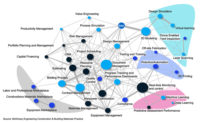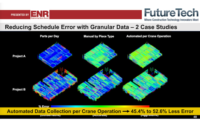“Imagine a pandemic shows up, what do you do then?”
That was the question posed by Rose Hall, strategic ops manager for risk engineering at AXA XL, the opening keynote speaker of ENR's annual FutureTech conference, happening entirely virtually for the first time. She added that enterprise software, field management, fleet telematics and worker wearables have enabled construction workers to go back to work and that is, “one positive thing to come out of COVID.”
Hundreds of professionals from construction, architecture, engineering and technology firms attended the virtual conference's first day and gained insight from contractors, venture capitalists, and the tech companies trying to answer a direct challenge about some of the biggest roadblocks to technology adoption in construction.
Moving past the familiar statistics on the industry’s reticence to try new technologies, Hall went to the heart of the problem. “Most senior leaders think innovation should come from the field, but most in the field think it should come from leadership…..you end up with a stalemate,” she explained.
Instead she says the companies that are able to drive innovation focus on having open forums where anyone can propose a new idea to be evaluated. But unless advancing these new ideas is a primary goal, they will fall by the wayside. "If [innovation] is everybody’s second job, folks are going to focus on production and performance and operations because it’s an afterthought.”
Hall adds that things are changing in today's environment as more firms become aware of how far along some of their competitors are with integrating new technology. She cited AXA XL’s new Technology Adoption Maturity Index (TAMI) as an example of how the industry is beginning to quantify their investments in technology innovation. “Now we can benchmark you against the industry and see where your peers are,” she says.
Hall, who has over 20 years experience in construction and risk management, said that imagery and extended reality, using artificial intelligence to stitch together construction site and progression pictures and using augmented reality to see 3D models superimposed over existing conditions are technologies that are becoming the “puzzle cover” of construction projects. She also said virtual reality walkthroughs for use cases will be beneficial for construction to maintain quality and reduce rework.
Contractors Explain Innovation
The bottom up approach to construction technology came more into focus in the first panel of FutureTech 2020, “The Human Side of Digital Transformation,” where speakers from contractors Clayco and DPR Construction emphasized aligning digital transformation with business objectives and ramping up collaboration both internally and externally.
“What does it mean from the perspective of digital transformation to work in a competitive environment?” asked Tomislav Žigo, vice president of virtual design and construction at Clayco. “Do we look at competitors in a traditional way, or is it about empowering collaboration and lessons learned?”
He noted that construction professionals can “look beyond the boundaries of our industry” at other industries, such as manufacturing, to gain more knowledge. He also noted that data has never been cheaper or more available to contractors, so the question has become: how best to use design, site and conditions data?
“The bulk of the work is really about gathering data. How do we assure future aspects of data management—bridging silos, facilitating integrated processes, ensuring data security, building data culture?”
Žigo added that “it’s absolutely necessary to define the maturity model of our current digital capabilities and start a dialogue where everyone has a voice. Once we understood the maturity level, the next was to define the maturity of future capability. Things become sticky. Leveraging expectations is always hard.”
Tim Gaylord, East Coast innovation leader for DPR, and Henning Roedel, his West Coast counterpart, described how the company ramped up employee engagement in innovation brainstorming and keeping track of pilot projects.
“A friendly internal competition was launched last year to give employees a platform to share ideas with the whole company,” Gaylord said. The two-week competition resulted in 172 ideas, as opposed to about 30 to 40 in previous years, he said. The seven finalists from different DPR regions pitched their ideas to a panel of judges—including Doug Woods, the “D” in DPR—during a livestreamed event.
On the Development Side
For the venture capitalists and entrepreneurs in attendance, the question of what to invest and how to nurture new construction technology ideas is at the forefront as today's market has only made solutions to common design and site problems more apparent.
In the session on New Ideas in Funding Technology, KP Reddy, CEO of Shadow Ventures announced the creation of an accelerator program in partnership with InfraShares, a platform that connects retail investors with early stage startups. Reddy is a serial entrepreneur and Shadow Venture is a seed-stage technology investment firm.
Reddy said he previously had been “pretty negative” about accelerator programs because he hasn’t “seen them create a lot of acceleration.” But this program will not just be “vetted by our team to make sure these investments are qualified and have the right tech and do all the work, but also to manage them for six months through the accelerator format,” he said. Because it’s crowdfunded, the investment will be available to all investors, including people like project managers on the front lines of making technology decision on projects, he added. And it’s a way to give startups “a bump in terms of capital,” he said. Reddy said the venture is coming soon, but not yet officially launched.
Brian Ross, CEO of InfraShares, another speaker on the panel, added, “Our partnership with Shadow Ventures adds a layer of oversight through an established angel investor VC entity that has a proven track record and a proven model for diligence.” It allows investors access to “a cohort in an accelerator program” where Shadow Ventures will help with management, business model, and “connections to open up opportunities” along with seed stage investment. Investors will have the benefit of diversification through a small portfolio of projects, he added, but still get access to the early stage start-ups.
Curtis Rodgers, a principal at Brick & Mortar Ventures, said his firm leverages industry partners to provide a strategic advantage to entrepreneurs “without any of the strategic strings attached.” The firm makes two major types of investments, he said, in the more disruptive business models “where we are selling directly to the end user,” and ones where the companies are “solving a common problem across multiple markets.”
Do people come to you with ideas? “Absolutely,” Rodgers said. “I actually pitched [Brick & Mortar CEO Darren Bechtel] and about 30 minutes into my idea he interrupted and offered me a job! I was an entrepreneur for about 30 minutes.” Rodgers considers himself “very fortunate to be on this side,” helping other entrepreneurs and sharing best practices. Among the lessons Rodgers shared: “An entrepreneur needs to have mental plasticity to be able to adapt to new information, to demonstrate to an investor and to know where your shortcomings are.”
Rodgers also said that Brick & Mortar looks for two types of businesses to invest in across construction: destructive business models such as Connect Homes, a modular home builder, and businesses models that solve problems across multiple markets that all involve construction, such as Cumulus Digital Systems' Internet of Tools-powered platform to manage industrial facilities.
Throughout the first day of FutureTech, many speakers hit upon the theme that are better ways to utilize the construction technologies that contractors and project teams can unleash today. Hall, the AXA XL risk manager, said that while only 18% of contractors are using mobile applications on their worksites, 75% have them available.
“There is an inability to unleash the entrepreneurial employees and get the most out of our teams," she said. "We can do better: we can move to the predictive model, then to the optimization model. This is where you grow your business, the predictive and optimizing stages.”











Post a comment to this article
Report Abusive Comment